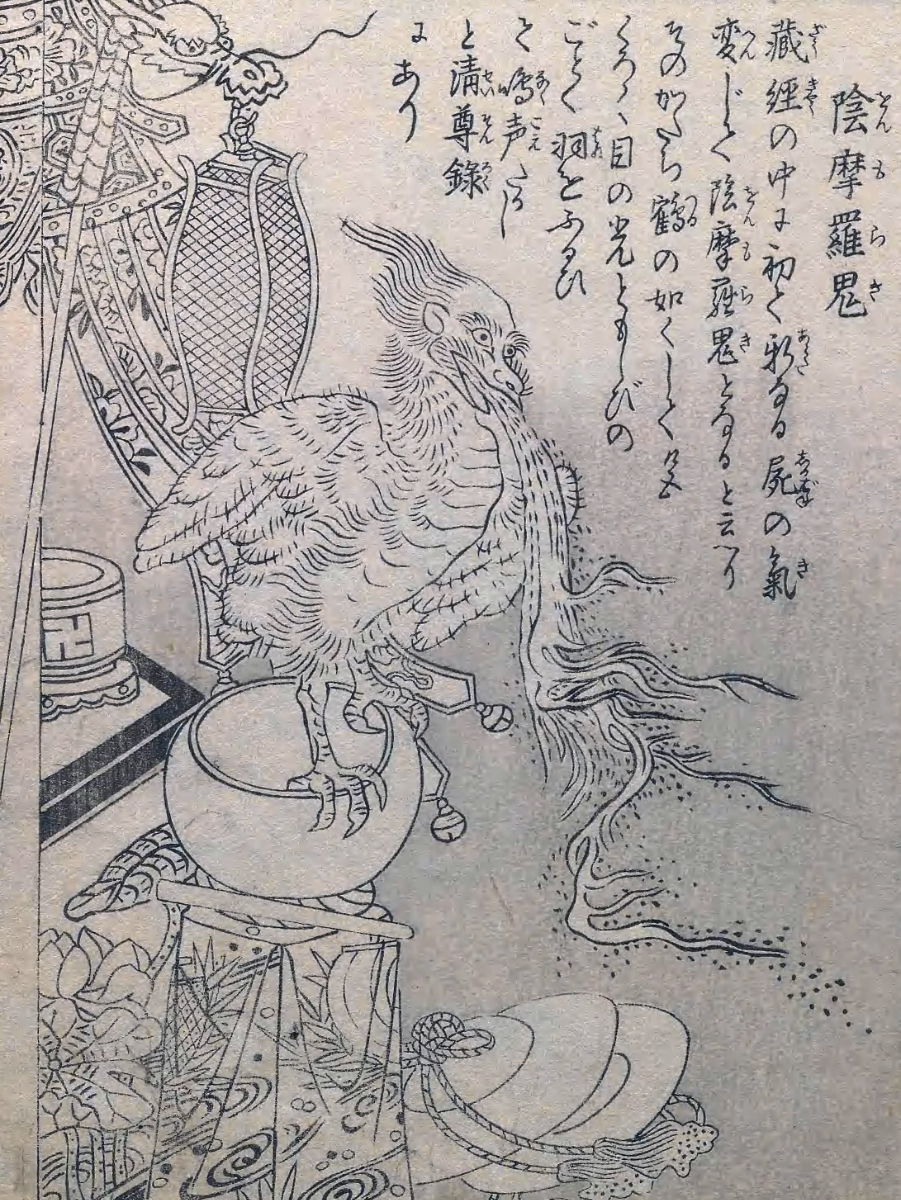Onmoraki are bird-like monsters with black feathers, bright eyes that shine like lanterns, and a ghastly human face. They are skilled mimics, and shake their feathers as they give off their shrill, terrifying call. Onmoraki appear near temples, particularly in the presence of neglectful priests. They sneak up on sleeping priests and surprise them, scolding them in a perfect imitation of their own voices. When the priest wakes up and flees in terror, the onmoraki vanishes into the shadows. Onmoraki come from the bodies of the recently deceased. When people die but do not receive enough memorial prayer, their life energy can transform into this grotesque, bird-like demon. The name onmoraki comes from a play on words emphasizing demonic interference with achieving Buddhist enlightenment. The first part of the name, on, comes from onmyō, the Japanese word for yin and yang. On represents yin, the shadow, the unseen, and hidden, secret things—in this case it refers to demons which live in the shadows and in the hidden parts of the world. The second part of the name, mora, refers to Mara, a Buddhist demon who personifies unskillfulness, impiety, and the death of the spirit—a reference to the poor quality of memorial services which cause this yōkai to come forth. The last part of the name, ki, simply means demon—emphasizing the fact that this monster truly is a demon.
| Alias Onmoraki (陰摩羅鬼) |
| Real Names/Alt Names “Shadowy unpious demon” |
| Characteristics Bird-themed, Yōkai, Enlightenment and Neoclassicism, Japanese |
| Creators/Key Contributors Toriyama Sekien, ○ |
| First Appearance Japanese folklore |
| First Publisher ○ |
| Appearance List Konjaku Gazu Zoku Hyakki (今昔画図続百鬼, “The Illustrated One Hundred Demons from the Present and the Past”, 1779) Vol. 2 |
| Sample Read Konjaku Gazu Zoku Hyakki Vol. 2 “Dark” (1779) [Smithsonian] |
| Description Onmoraki are bird-like monsters with black feathers, bright eyes that shine like lanterns, and a ghastly human face. They are skilled mimics, and shake their feathers as they give off their shrill, terrifying call. Onmoraki appear near temples, particularly in the presence of neglectful priests. They sneak up on sleeping priests and surprise them, scolding them in a perfect imitation of their own voices. When the priest wakes up and flees in terror, the onmoraki vanishes into the shadows. Onmoraki come from the bodies of the recently deceased. When people die but do not receive enough memorial prayer, their life energy can transform into this grotesque, bird-like demon. The name onmoraki comes from a play on words emphasizing demonic interference with achieving Buddhist enlightenment. The first part of the name, on, comes from onmyō, the Japanese word for yin and yang. On represents yin, the shadow, the unseen, and hidden, secret things—in this case it refers to demons which live in the shadows and in the hidden parts of the world. The second part of the name, mora, refers to Mara, a Buddhist demon who personifies unskillfulness, impiety, and the death of the spirit—a reference to the poor quality of memorial services which cause this yōkai to come forth. The last part of the name, ki, simply means demon—emphasizing the fact that this monster truly is a demon. |
| Source Onmoraki – Yokai.com |

